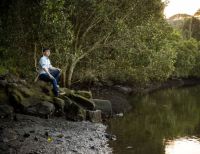
Dr Alessandro Tuniz (left) and Associate Professor Boris Kuhlmey in their Sydney Nanoscience Hub laboratory. Photo: Stefanie Zingsheim
Ever since Antonie van Leeuwenhoek discovered the world of bacteria through a microscope in the late seventeenth century, humans have tried to look deeper into the world of the infinitesimally small.
There are, however, physical limits to how closely we can examine an object using traditional optical methods. This is known as the ‘diffraction limit’ and is determined by the fact that light manifests as a wave. It means a focused image can never be smaller than half the wavelength of light used to observe an object.
Attempts to break this limit with “super lenses” have all hit the hurdle of extreme visual losses, making the lenses opaque. Now physicists at the University of Sydney have shown a new pathway to achieve superlensing with minimal losses, breaking through the diffraction limit by a factor of nearly four times. The key to their success was to remove the super lens altogether.
The research is published today in Nature Communications.
The work should allow scientists to further improve super-resolution microscopy, the researchers say. It could advance imaging in fields as varied as cancer diagnostics, medical imaging, or archaeology and forensics.
Lead author of the research, Dr Alessandro Tuniz from the School of Physics and University of Sydney Nano Institute, said: “We have now developed a practical way to implement superlensing, without a super lens.
“To do this, we placed our light probe far away from the object and collected both high- and low-resolution information. By measuring further away, the probe doesn’t interfere with the high-resolution data, a feature of previous methods.”
Previous attempts have tried to make super lenses using novel materials. However, most materials absorb too much light to make the super lens useful.














